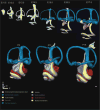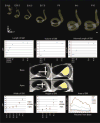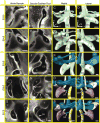Scanning thin-sheet laser imaging microscopy elucidates details on mouse ear development
- PMID: 22271591
- PMCID: PMC5010664
- DOI: 10.1002/dvdy.23736
Scanning thin-sheet laser imaging microscopy elucidates details on mouse ear development
Erratum in
- Dev Dyn. 2013 May;242(5):591-2
Abstract
Background: The mammalian inner ear is transformed from a flat placode into a three-dimensional (3D) structure with six sensory epithelia that allow for the perception of sound and both linear and angular acceleration. While hearing and balance problems are typically considered to be adult onset diseases, they may arise as a developmental perturbation to the developing ear. Future prevention of hearing or balance loss requires an understanding of how closely genetic mutations in model organisms reflect the human case, necessitating an objective multidimensional comparison of mouse ears with human ears that have comparable mutations in the same gene.
Results: Here, we present improved 3D analyses of normal murine ears during embryonic development using optical sections obtained through Thin-Sheet Laser Imaging Microscopy. We chronicle the transformation of an undifferentiated otic vesicle between mouse embryonic day 11.5 to a fully differentiated inner ear at postnatal day 15.
Conclusions: Our analysis of ear development provides new insights into ear development, enables unique perspectives into the complex development of the ear, and allows for the first full quantification of volumetric and linear aspects of ear growth. Our data provide the framework for future analysis of mutant phenotypes that are currently under-appreciated using only two dimensional renderings.
Copyright © 2012 Wiley Periodicals, Inc.
Figures









References
Publication types
MeSH terms
Grants and funding
- R01 DC007588/DC/NIDCD NIH HHS/United States
- P30 DC010362/DC/NIDCD NIH HHS/United States
- R01-DC055095590/DC/NIDCD NIH HHS/United States
- UL1RR024979/RR/NCRR NIH HHS/United States
- UL1 RR024979/RR/NCRR NIH HHS/United States
- R21 DC005482/DC/NIDCD NIH HHS/United States
- T32 GM007337/GM/NIGMS NIH HHS/United States
- DC007588-03S1/DC/NIDCD NIH HHS/United States
- TL1 RR024981/RR/NCRR NIH HHS/United States
- R01-DC007588/DC/NIDCD NIH HHS/United States
- R01 DC005590/DC/NIDCD NIH HHS/United States
- P30 DC 010362/DC/NIDCD NIH HHS/United States
LinkOut - more resources
Full Text Sources

